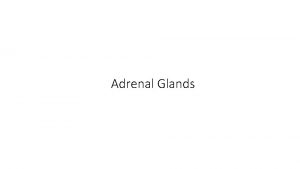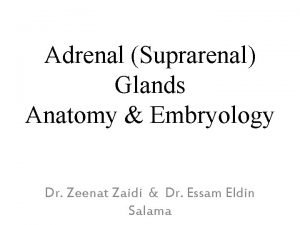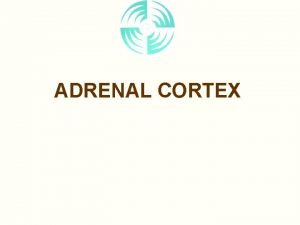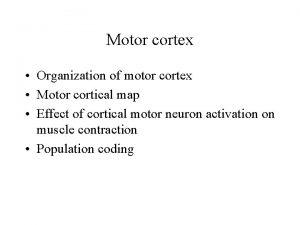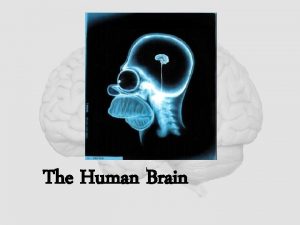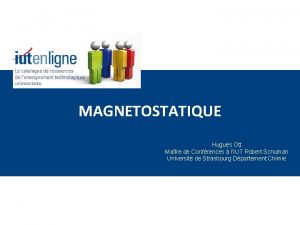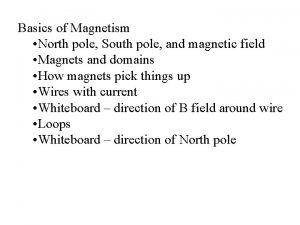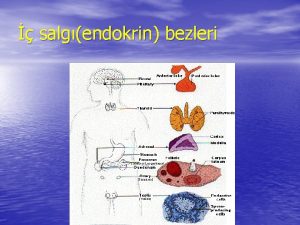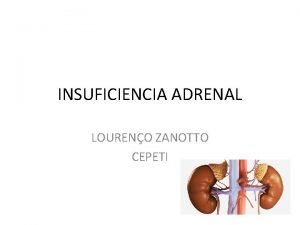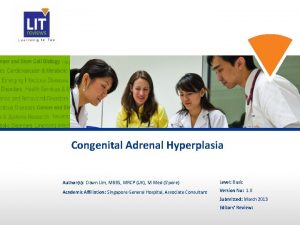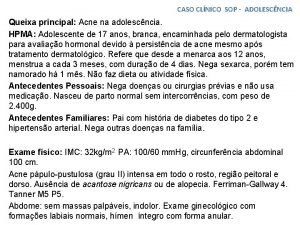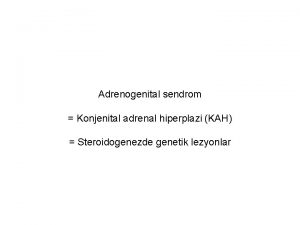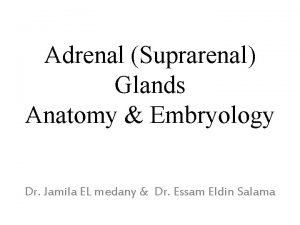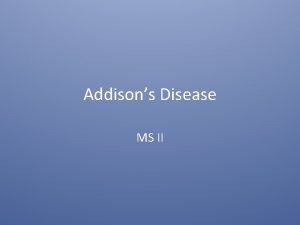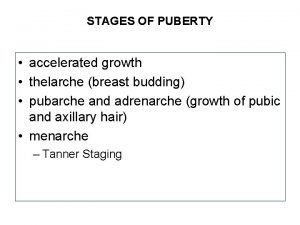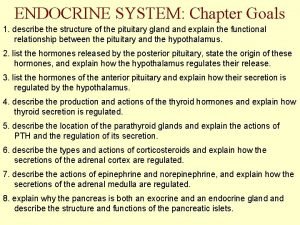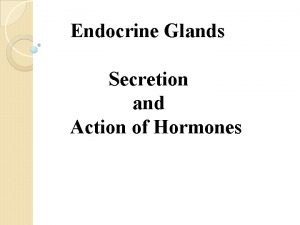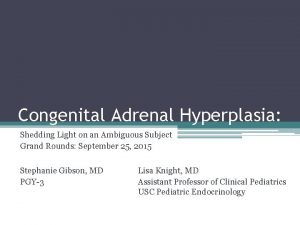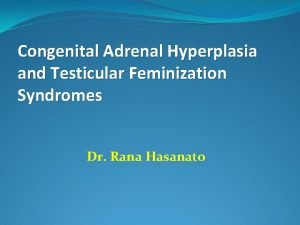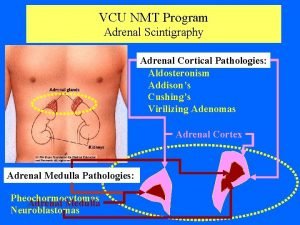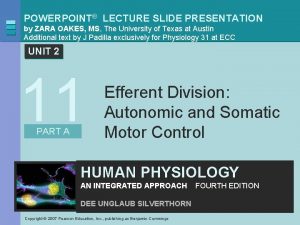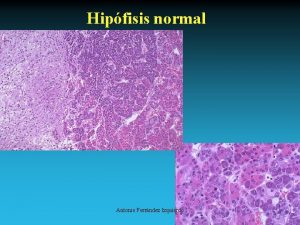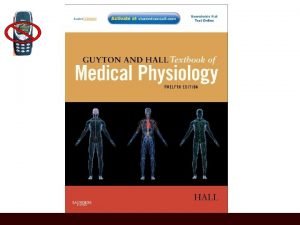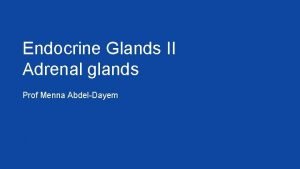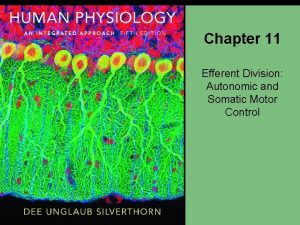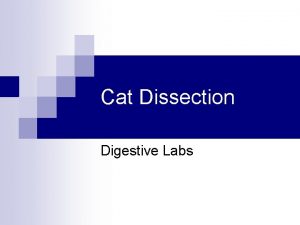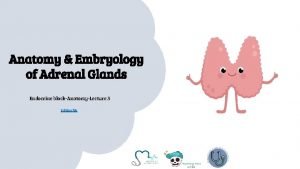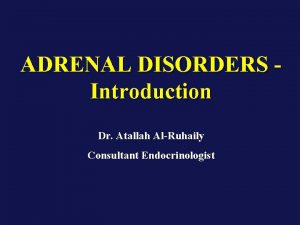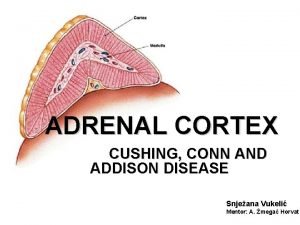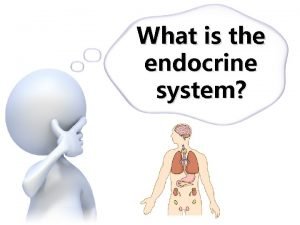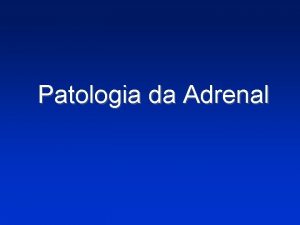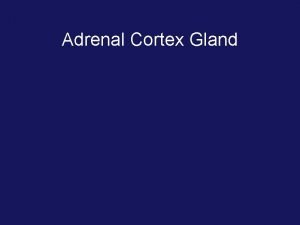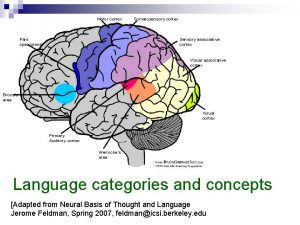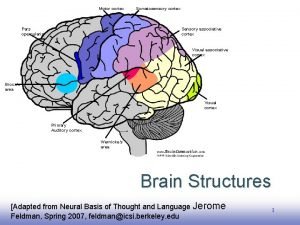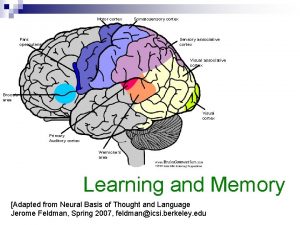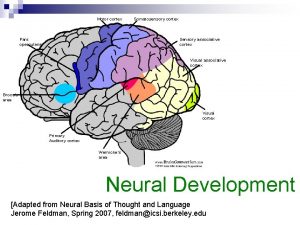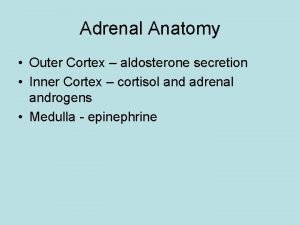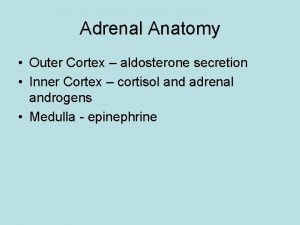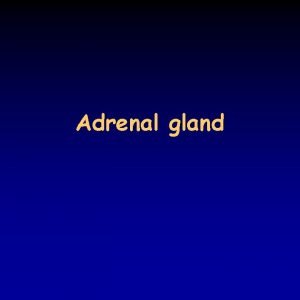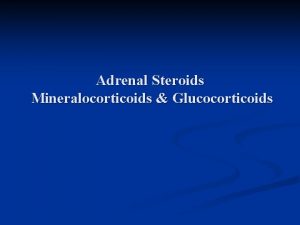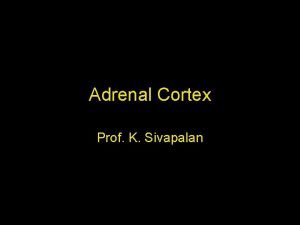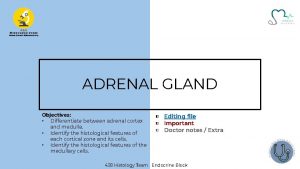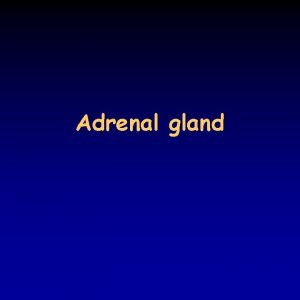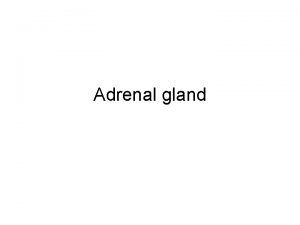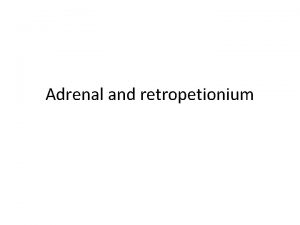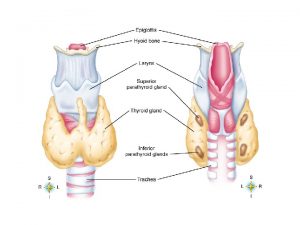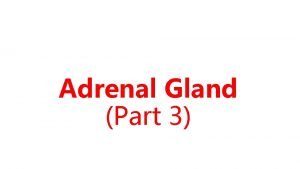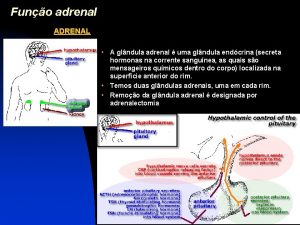ADRENAL CORTEX Introduction Adrenal Location Superior Pole of










































- Slides: 42

ADRENAL CORTEX

Introduction • Adrenal Location – Superior Pole of each Kidney – Retroperitoneal – Embedded in the Perirenal fat pad. – Left gland sits slightly more superior than right gland

Adrenal Gland • Adrenal Cortex • Adrenal Medulla/ Chromaffin Tissue • Different embryological origins • Not together below birds

Adrenal Cortex • Embryology – Intermediate Mesoderm • Zones – Zona Glomerulosa – Zona Fasciculata – Zona Reticularis Medulla

Adrenal Cortex Cytology • Lipid Inclusions • Well Developed SER • Mitochondria with Tubular Cristae • Capillary Adjacent to each Cell

Cholesterol Side Chain • LDL • De Novo Synthesis

Mineralocorticoids Side-Chain Cleavage 3 -OH dehydrogenase Steroid Pathways Gluco. Androgens corticoids Estrogen Aromatase 21 -hydroxylase 11 -hydroxylase 18 -OH steroid dehydrog. 17 -OH Steroid Dehydrogenase 17 -OHase C 17 -20 Lyase 16 -OHase

Mineralocorticoids

Mineralocorticoids Side-Chain Cleavage 3 -OH dehydrogenase Z. Glomerulosa Gluco. Androgens corticoids Estrogen Aromatase 21 -hydroxylase 11 -hydroxylase 18 -OH steroid dehydrog. 17 -OH Steroid Dehydrogenase 17 -OHase C 17 -20 Lyase 16 -OHase

Mineralocorticoids • • C-21 Steroids Primarily produced by zona glomerulosa Principal mineralocorticoid is aldosterone Aldosterone actions – Promote Na+ reabsorption – Inhibit K+ reabsorption – Antidiuretic – Acts primarily on the cortical collecting duct & DCT

Regulation of Aldosterone Secretion Na+ K+ Na+ K+ Z. Glomerulosa Aldosterone Na+ Reabsorption Kidney K+ Reabsorption

Regulation of Aldosterone Secretion Angiotensinogen Kidney Juxtaglomerular Renin Cells Blood Pressure Angiotensin-I Blood Volume Water Reabsorption Na+ Reabsorption Kidney Lung Converting Enzyme Angiotensin-II Aldosterone Z. Glomerulosa

Regulation of Aldosterone Secretion Hypothalamus CRH Anterior Pituitary ACTH Z. Glomerulosa Aldosterone

Atrial Natriuretic Hormone • 28 amino acid peptide • Similar peptides produced in other organs • Actions – c. GMP is second messenger – Increases GFR – Inhibits Na+ and water reabsorption

Regulation of ANH Venous Return Atrial Stretch Receptors ANH Blood Volume Kidney Water Reabsorption Na+ Reabsorption

Glucocorticoids

Mineralocorticoids Side-Chain Cleavage 3 -OH dehydrogenase Z. Fasiculata Gluco. Androgens corticoids Estrogen Aromatase 21 -hydroxylase 11 -hydroxylase 18 -OH steroid dehydrog. 17 -OH Steroid Dehydrogenase 17 -OHase C 17 -20 Lyase 16 -OHase

Which ones are glucocorticoids? • • Cortisol 11 -deoxycorticosterone 17 -hydroxyprogesterone 17 -hydroxypregnenolone • Cortisol Most Potent • 11 -deoxycorticosterone, very weak, but does act as feedback effector and has potent mineralocorticoid activity. • Remainder are inactive

Serum binding proteins • Corticosteroid binding globulin (CBG) – 75% of Cortisol bound to CBG – 10% of Aldosterone bound to CBG • Albumin – 15% of Cortisol bound to Albumin – 50% of Aldosterone bound to Albumin • Free – 10 % of Cortisol – 40 % of Aldosterone

Actions of the Glucocorticoids

Anti-inflammatory • Inhibit Prostaglandin production – Inhibit phospholipase A 2 • Inhibit secretion of Interleukin-I • Prevents movement of PMNs, lymphocytes, & monocytes from blood into areas of injury. • Decrease lymphocyte production

Intermediary Metabolism • • • Stimulates gluconeogenesis Protein catabolic Decrease glucose catabolism Increase lipolysis Inhibit DNA synthesis.

Growth • Glucocorticoids inhibit mitosis • Inhibit bone formation and mineralization – Decrease intestinal absorption of Ca++ – Stimulates PTH (secondarily)

Connective Tissues • Inhibit collagen formation • Decreased bone deposition

Blood • Increased intravascular levels of neutrophils • Decreased intravascular levels of lymphocytes, monocytes, & eosinophils • Diminished immune response

Cardiovascular • Increase blood pressure – Increased cardiac output – Increased vascular tone – Possibly augmenting action of catecholamines – Increasing number of adrenergic receptors

Effects on CNS • Easily enter Brain • Neurons have glucocorticoid receptors • Physiologic effect unknown • Excess or deficiency of glucocorticoids known to profoundly alter behavior and cognitive function.

Effects on Other Hormones • Inhibit TSH production • Inhibit Gn. RH production

Ulcer formation • Inhibit Prostaglandin production • Immunosuppression

ACTH Side-Chain Cleavage 3 -OH dehydrogenase Mineralocorticoids Z. Fasiculata Gluco. Androgens corticoids Estrogen Aromatase 21 -hydroxylase 11 -hydroxylase 18 -OH steroid dehydrog. 17 -OH Steroid Dehydrogenase 17 -OHase C 17 -20 Lyase 16 -OHase

Regulation of Glucocorticoid Secretion STRESS Circadian Rhythm Hypothalamus CRH Anterior Pituitary ACTH Z. Fasciculata & Reticularis Cortisol

General Adaptation Syndrome (Selye) Cortisol STRESS • Alarm • Resistance • Exhaustion---Death Time

Adrenal Androgens • Dehydroepiandrosterone (DHEA) – DHEA-S • Androstenedione

Fetal Adrenal Cortex • Develops first in fetal adrenal gland • Produces androgens (DHEA) • Replaced by definitive cortex

Pathologies of the Adrenal Cortex

Adrenocortical Insufficiency (Addison’s Disease) • Signs & symptoms – Weakness, Fatigue – Anorexia, Weight loss – Hyperpigmentation (primary only) – Hypotension – G-I disturbances – Salt craving • Crisis • Treatment

Hypersecretion (Cushing’s Disease) • Primary, secondary, or tertiary • Ectopic ACTH production • Signs and symptoms – Obesity – Thinning of the skin – Striae – Hirsutism – Hypertension

Hypersecretion (Cushing’s Disease) – Weakness – Gonadal dysfunction – Glucose intolerance • Treatment

Androgenital syndrome • Excess adrenal androgen production. • Maybe due to tumor

Enzyme Deficiencies Side-Chain Cleavage 3 -OH dehydrogenase 21 -Hydroxylase Deficiency 21 -hydroxylase 17 -OHase C 17 -20 Lyase

Enzyme Deficiencies Side-Chain Cleavage 3 -OH dehydrogenase 11 -Hydroxylase Deficiency 21 -hydroxylase 11 -hydroxylase 17 -OHase C 17 -20 Lyase

Enzyme Deficiencies Side-Chain Cleavage 3 -OH dehydrogenase 3 -Hydroxysteroid Dehydrogenase Deficiency 17 -OHase C 17 -20 Lyase
 Raa pathway
Raa pathway Adrenal cortex develops from
Adrenal cortex develops from Adrenal medulla cortex
Adrenal medulla cortex Adrenal cortex and medulla
Adrenal cortex and medulla Motor cortex sensory cortex
Motor cortex sensory cortex Which lobe is broca's area in
Which lobe is broca's area in Aimant pole nord pole sud
Aimant pole nord pole sud Wave armature winding
Wave armature winding Define north pole and south pole
Define north pole and south pole A cross country skier moves from location a
A cross country skier moves from location a In location planning the location of raw materials
In location planning the location of raw materials Visceral nervous system
Visceral nervous system Adrenal bez histolojisi
Adrenal bez histolojisi Arritimias
Arritimias Dr dawn lim
Dr dawn lim Hiperplasia adrenal congênita não clássica
Hiperplasia adrenal congênita não clássica Dişi psödohermafroditizm
Dişi psödohermafroditizm Relation of adrenal gland
Relation of adrenal gland What causes addisons disease
What causes addisons disease Oktay eray
Oktay eray Congenital adrenal hyperplasia characteristics
Congenital adrenal hyperplasia characteristics Menopause and mania
Menopause and mania Hypoglycemic shock
Hypoglycemic shock Adrenal nervous system
Adrenal nervous system Cow adrenal gland
Cow adrenal gland Non classical adrenal hyperplasia
Non classical adrenal hyperplasia Virilisation in females
Virilisation in females Adrenal gland hormone
Adrenal gland hormone Adrenal bez embriyolojisi
Adrenal bez embriyolojisi Adrenal cushing
Adrenal cushing Congenital adrenal hyperplasia genitalia
Congenital adrenal hyperplasia genitalia Adrenal sympathetic pathway
Adrenal sympathetic pathway Adrenal tumour
Adrenal tumour Congenital adrenal hyperplasia
Congenital adrenal hyperplasia Adrenal gland regions
Adrenal gland regions Adrenal cushing
Adrenal cushing Adrenal sympathetic pathway
Adrenal sympathetic pathway Cat digestive
Cat digestive Betoderm
Betoderm Adrenal glands
Adrenal glands Adrenal gland regions
Adrenal gland regions Conns and addison's
Conns and addison's Adrenal gland
Adrenal gland
